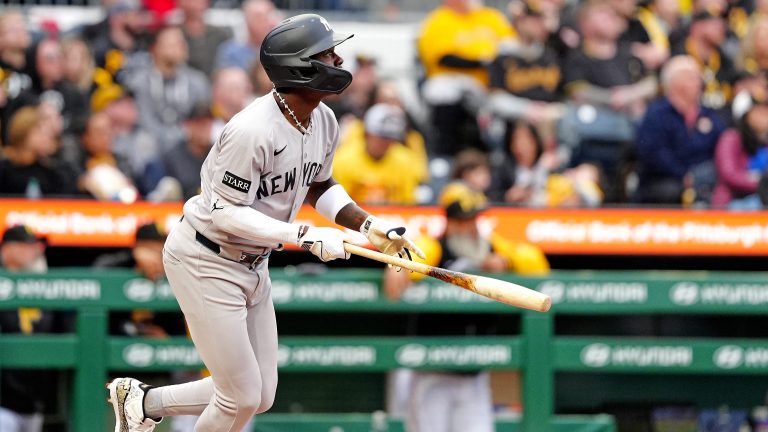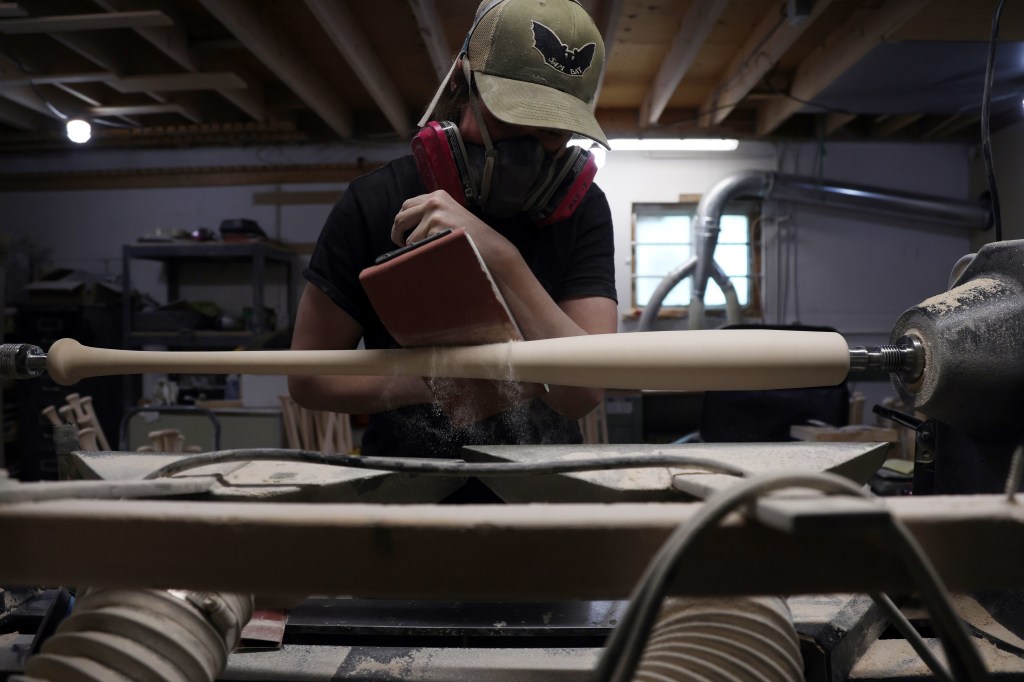What to Make of the Most Talked-About Bat in Baseball
The torpedo bat has been taking MLB by storm to open the 2025 season. Let's hear from the inventor and break down the new phenomenon.

It’s been just two weeks since Opening Day, but it only took one series for a defining subplot of the 2025 season to emerge: torpedo bats. The controversial new equipment immediately stole headlines when the New York Yankees hit an incredible 15 home runs across their first three-game series of the season, with a number of the slugging players — including Jazz Chisholm Jr., Anthony Volpe, Austin Wells, Cody Bellinger, and Paul Goldschmidt — swinging torpedo bats.
Rumors quickly began swirling that the new bats offered an advantage to players, with many fans criticizing their use. Meanwhile, the torpedo bats’ inventor — Miami Marlins’ field coordinator Aaron Leanhardt — says the development was a long time coming.
“It’s always good to see the game of baseball making progress,” Leanhardt said in a recent phone interview with Just Baseball’s Jack McMullen, the Wall Street Journal’s Jared Diamond, and The Athletic’s Brendan Kuty. “This has been probably about a two-year project, maybe over two years ago, some guys in the big leagues, some guys in the minor leagues started started swinging these things. It was something that really came out of conversations with the players.”
For those unfamiliar, torpedo bats are customized bats that distribute weight in the barrel differently for each hitter. Traditional bats have a slim handle, expand in width around halfway up the barrel, and then maintain that same thickness to the end, but torpedo bats are crafted in a way that ensures the barrel is widest at the point where the player makes contact — the “sweet spot” — before tapering back down at the end.
The main idea behind torpedo bats is that by shifting mass to where players most often hit the ball, greater impact can be made on contact, thereby increasing slugging. There’s also chatter about torpedo bats offering increased bat speed due to the weight sitting lower on the barrel and the end of the bat being lighter, and while it makes sense in theory, the data on this is inconclusive.
“There are some fairly intricate design details where, in some sense, you can make the swing weight about whatever you want,” Leanhardt said. “You can still keep the same length and weight and feel in the player’s hands, which is a fancy way of saying the bat speed should stay the same, maybe the bat speed can even increase a little bit depending on how you want to redesign the bat.”
So, where did torpedo bats come from, and — with the Yankees’ impressive stats leading the way — are traditional bats about to become a thing of the past?
The Beginning of the Torpedo Bat

The torpedo bat’s invention dates back to 2022-23, when Leanhardt was the Yankees’ assistant minor league hitting coordinator. A former physicist with a doctorate from MIT, Leanhardt started talking to hitters about changes they could make at the plate to counteract the leaps and bounds being made by pitchers — and an idea was sparked.
“A huge part of my job… is really just to be a good listener,” Leanhardt said. “[Players] want to make more contact, they want to barrel the ball up better, things like that… so we just started thinking of it from the perspective of a player might have a 31 ounce, a 31.5 ounce, to 32 ounce wood budget, and the question is, how do you want to spend your wood budget on a bat? How much of that weight do you want to put in different places?”
“Ultimately the players decided themselves that they want to put the most weight at the sweet spot… and that just simply means it has to come from somewhere else. It ended up coming from from the tip of the bat and so the actual shape, the final product looks pretty dramatic, but the concept is fairly simple.”
Throughout the 2023 and 2024 seasons, Leanhardt worked with bat manufacturers to create different prototypes, using hitting data to determine the location of each player’s “sweet spot” on the barrel, getting feedback, and making adjustments. While it’s unclear exactly when the torpedo bat was first used in the majors, the Yankees’ Giancarlo Stanton and the New York Mets’ Francisco Lindor both notably swung them during games last season, and after their impressive stats, more and more players started paying attention.
Torpedo Bats are Both Allowed and “Absolutely Good for Baseball,” According to MLB Commissioner Rob Manfred
At this stage, there’s no definitive proof that hitters have an advantage when they use torpedo bats instead of traditional ones — but if there’s even a credible chance these new bats are offering a leg-up to players, why are they allowed in MLB?
Well, the regulations surrounding bat specifications aren’t particularly strict, and as of right now, torpedo bats meet the requirements needed to remain in play.
Under Rule 3.02(a) of MLB’s Official Baseball Rules, a bat is allowed to be used so long as it is “a smooth, round stick not more than 2.61 inches in diameter at the thickest part and not more than 42 inches in length” and made from “one piece of solid wood.” The Rules also state that experimental bats are not allowed to be used in games “until the manufacturer has secured approval from Major League Baseball of his design and methods of manufacture,” but considering MLB commissioner Rob Manfred’s recent comments of support, it can be assumed that the required approval has indeed been secured.
“[Torpedo bats are] absolutely good for baseball,” Manfred told the New York Times’ Michael S. Schmidt on April 6. “I believe that issues like the torpedo bat and the debate around it demonstrate the fact that baseball still occupies a unique place in our culture, because people get into a complete frenzy over something that’s really nothing at the end of the day.”
“The bats comply with the rules,” he continued. “Players have actually been moving the sweet spot around in bats for years. But it just demonstrates that something about the game is more important than is captured by television ratings or revenue or any of those things, when you have the discussions and debates about it.”
Why Isn’t Every Team Using Torpedo Bats?
While the Yankees have gotten a lot of the attention for their use of torpedo bats, they aren’t the only team utilizing them. So far this season, the Cincinnati Reds’ Elly De La Cruz, the Chicago Cubs’ Dansby Swanson and Nico Hoerner, the Pittsburgh Pirates’ Oneil Cruz, and the Baltimore Orioles’ Adley Rutschman have all been spotted with the new bats, as have a slew of other players across MLB.
“It doesn’t feel like a different bat,” the Yankees’ Chisholm told CNN’s Julia Andersen. “It just helps you in a little way. I don’t know the science of it… I think I still hit the ball the same, like, exit velocity as I always did. I just feel like it gives you a feeling of – just feeling like you have more to work with. You probably don’t have more to work with, but it feels like it.”
But not everyone is convinced. Multiple players have tried out the torpedo bats but then gone back to their traditional ones — including the Philadelphia Phillies’ Alec Bohm — and some hitters simply aren’t interested in changing their bats at all.
Aaron Judge, who slammed four of the Yankees’ 15 home runs during the team’s impressive opening series, insists he has no plan to switch up his equipment.
“The past couple of seasons kind of speak for itself,” he told Andersen. “Why try to change something?”
Still, it looks like torpedo bats are here to stay.
On March 30, ESPN’s Buster Olney reported that the Atlanta Braves had already put in an order for the new bats after seeing the Yankees’ home run extravaganza, and more and more players seem to be using them in games.
Leanhardt, for one, is excited by the progress.
“It’s evolved over time, and I think it’s going to continue to evolve over time …” Leanhardt said. “This has been a multi-year project and involved a lot of players and a lot of coaches who are now spread throughout the league, and my biggest takeaway is that this is what innovation can give the game, and we should all push the envelope in that area.”
